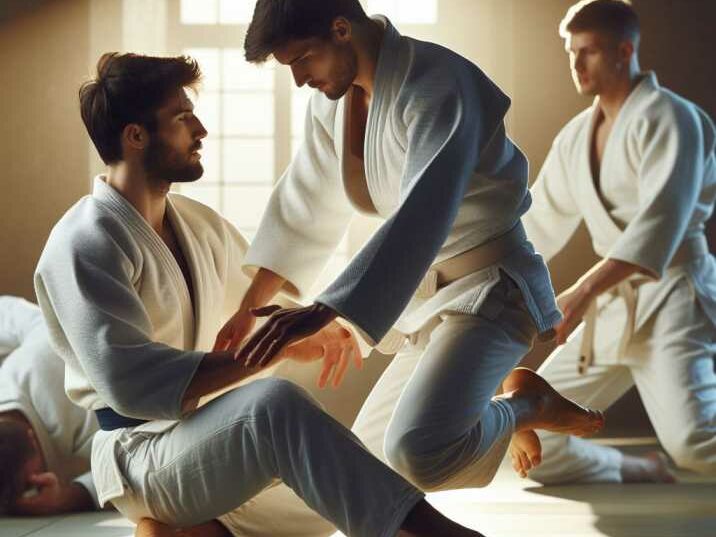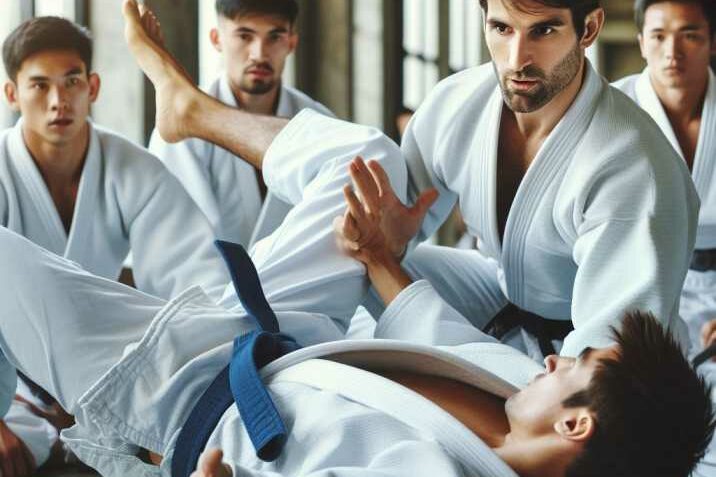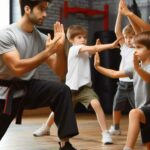Introduction:
Table of Contents
In a world where physical activity is celebrated, martial arts stand out as a unique blend of discipline, fitness, and self-defense. However, for many beginners, concerns about injuries can be a significant deterrent. That’s where Judo shines. Judo, often dubbed as the gentle way, offers a holistic approach to martial arts, prioritizing safety without compromising effectiveness. Let’s delve into the world of Judo to understand why it’s hailed as the safest martial art.

The Safest Martial Art
History of Judo: Judo’s Origins:
Judo, which translates to “gentle way” in English, emerged in Japan during the late 19th century. Its creation is credited to Jigoro Kano, a visionary educator and martial artist. Inspired by his passion for physical education and martial arts, Kano set out to develop a new system that would embody the principles of efficiency, adaptability, and personal growth.
Development by Jigoro Kano:
Jigoro Kano was deeply influenced by the martial traditions of Japan, including jujutsu, which focused on unarmed combat techniques. Recognizing the limitations of traditional jujutsu, Kano sought to refine its techniques and principles into a more practical and comprehensive system. He spent years studying various styles of jujutsu, analyzing their strengths and weaknesses, and synthesizing them into a cohesive framework.
Philosophy and Principles:
Central to Kano’s vision was the belief that martial arts should serve as a vehicle for individual development, both physically and mentally. He emphasized the importance of mutual respect, self-discipline, and continuous improvement in one’s practice. By embracing the concept of “maximum efficiency with minimum effort,” Kano sought to empower practitioners to overcome opponents through skillful technique rather than brute force.
Establishment of the Kodokan:
In 1882, Jigoro Kano founded the Kodokan Judo Institute in Tokyo, which served as the headquarters for his new martial art. The Kodokan became a hub for Judo training, research, and philosophy, attracting students from all walks of life, including military personnel, athletes, educators, and intellectuals. Under Kano’s guidance, the Kodokan flourished as a center of innovation and excellence in martial arts education.
Spread and Globalization:
Through the efforts of Kano and his dedicated followers, Judo gained popularity both within Japan and internationally. Kano traveled extensively, promoting Judo and establishing relationships with martial artists and educators worldwide. In 1964, Judo made its debut as an official Olympic sport at the Tokyo Games, further cementing its status as a global phenomenon.
Legacy of Jigoro Kano:
Jigoro Kano’s legacy extends far beyond the realm of martial arts. As an educator and reformer, he played a pivotal role in modernizing Japan’s educational system and promoting the values of sportsmanship, cooperation, and personal development. His teachings continue to inspire generations of Judo practitioners, who strive to embody the principles of “maximum efficiency” and “mutual welfare” in their practice and daily lives.
By establishing Judo as a synthesis of traditional martial arts and modern philosophy, Jigoro Kano created a timeless legacy that continues to shape the lives of millions of practitioners around the world. The Kodokan remains a symbol of excellence and innovation, preserving Kano’s vision for future generations to embrace and build upon.
Judo Techniques:
- Judo techniques are categorized into throwing techniques (nage-waza), grappling techniques (katame-waza), and striking techniques (atemi-waza).
- Throws in Judo utilize leverage, balance, and timing to off-balance opponents and bring them to the ground.
- Grappling techniques include pins, joint locks, and chokeholds, which are used to control or immobilize opponents on the ground.
- Strikes (atemi) are used strategically to create openings for throws or to distract opponents during grappling exchanges.
Judo Training and Ranking System:
- Judo training typically consists of warm-up exercises, technical instruction, drilling of techniques, and live sparring (randori).
- The Judo ranking system, represented by colored belts (kyu and dan ranks), signifies a practitioner’s skill level and progression within the art.
- Beginners start with white belts and progress through various colored belts (yellow, orange, green, blue, brown) before reaching black belt (dan) ranks.
- Advancement to higher ranks requires proficiency in Judo techniques, knowledge of Judo principles, and demonstration of good character and sportsmanship.
International Judo Federation (IJF) and Competitions:
- The International Judo Federation (IJF) governs and promotes Judo worldwide, overseeing international competitions and events.
- Major Judo competitions include the World Judo Championships, held annually, and the Olympic Games, where Judo has been a featured sport since 1964.
- Judo competitions are conducted under strict rules and regulations, ensuring fair play, safety, and sportsmanship among athletes.
Benefits of Judo for Children:
- Judo offers numerous benefits for children, including physical fitness, coordination, discipline, and confidence.
- Judo training helps children develop important life skills such as teamwork, respect for others, and resilience in the face of challenges.
- Many parents enroll their children in Judo classes to instill values of self-discipline, perseverance, and respect from a young age.
Judo for Self-Defense and Personal Safety:
- While Judo is often practiced as a sport, its techniques are highly effective for self-defense in real-life situations.
- Judo teaches practitioners how to defend against various types of attacks, including grabs, strikes, and ground assaults, using leverage, balance, and timing to neutralize threats.
- By mastering Judo techniques, individuals gain confidence in their ability to protect themselves and others without relying on physical strength or aggression.
Understanding Judo’s Safety Measures
1. Technique Over Strength:
In Judo, practitioners learn to use their opponent’s momentum and strength against them, rather than relying solely on their own force. This emphasis on technique over brute strength reduces the risk of injuries, making it suitable for people of all ages and sizes. Beginners are taught fundamental techniques such as throws, pins, and joint locks, focusing on proper execution rather than overpowering opponents.
2. Controlled Environment:
Judo is practiced on soft mats, known as tatami, which provide cushioning against falls. This controlled environment minimizes the impact of throws and takedowns, significantly reducing the risk of injuries compared to hard surfaces. Additionally, judo dojos are equipped with safety measures such as padded walls and ample space to ensure a safe training environment.
3. Emphasis on Breakfalls:
Central to Judo training are breakfall techniques, which teach practitioners how to fall safely and efficiently. By mastering breakfalls, practitioners can mitigate the impact of throws and avoid injuries commonly associated with falling. Beginners spend considerable time learning and practicing breakfalls under the guidance of experienced instructors to develop proper falling techniques and instincts.
4. Respect and Mutual Welfare:
Judo places a strong emphasis on respect, mutual welfare, and cooperation between training partners. Practitioners are taught to control their techniques and apply them safely, fostering a culture of safety within the dojo. Mutual trust and respect among judoka (Judo practitioners) create a supportive environment where safety is paramount, encouraging open communication and collaboration during training sessions.
5. Progressive Learning:
Judo training progresses gradually, starting with basic movements and techniques before advancing to more complex maneuvers. This gradual approach allows beginners to develop their skills incrementally, reducing the likelihood of injuries due to overexertion or improper form. Experienced instructors tailor training sessions to accommodate individuals’ skill levels and physical capabilities, ensuring a safe and enjoyable learning experience for all.

The Impact of Judo’s Safety Measures
Reduced Risk of Injury:
By prioritizing safety in its techniques and training methods, Judo boasts one of the lowest injury rates among martial arts. According to a study published in the Journal of Sports Science and Medicine, Judo has a lower injury rate compared to other combat sports like boxing and Taekwondo. This makes it an ideal choice for beginners looking to learn self-defense skills without risking serious injury.
Improved Physical Fitness:
Despite its gentle approach, Judo offers a comprehensive workout that improves cardiovascular health, strength, flexibility, and agility. Practitioners engage in dynamic movements such as throws, sweeps, and grappling techniques, providing a full-body workout that enhances overall fitness. Regular Judo training not only strengthens muscles and improves endurance but also promotes better coordination and balance, contributing to overall physical well-being.
Enhanced Self-Defense Skills:
While safety is paramount in Judo, it doesn’t compromise on effectiveness. Judo techniques are practical and efficient, providing practitioners with valuable self-defense skills that can be applied in real-life situations. Whether defending against grabs, strikes, or ground attacks, judoka learn to anticipate and neutralize threats using leverage, timing, and proper technique. This empowers individuals to protect themselves and others without resorting to excessive force or aggression.
Cultivation of Discipline and Focus:
Beyond physical benefits, Judo instills discipline, focus, and mental resilience in its practitioners. Through rigorous training and adherence to dojo etiquette, students learn valuable life skills that extend beyond the mat. Judo principles such as perseverance, respect, and self-control are reinforced through repetitive drills, sparring sessions, and belt promotion exams. This fosters a sense of responsibility and integrity, shaping individuals into confident and well-rounded martial artists.
Table of Information:
| Aspect | Description |
|---|---|
| Injury Rate | Judo boasts one of the lowest injury rates among martial arts disciplines, making it ideal for beginners. |
| Training Environment | Judo is practiced on soft mats, known as tatami, which provide cushioning against falls and reduce impact. |
| Core Principles | Judo emphasizes respect, mutual welfare, and cooperation, fostering a safe and supportive training environment. |
| Self-Defense Skills | Judo techniques are practical and efficient, equipping practitioners with valuable self-defense skills. |
| Physical Fitness Benefits | Judo offers a comprehensive workout, improving cardiovascular health, strength, flexibility, and agility. |
Conclusion:
In the realm of martial arts, safety should always be a top priority, especially for beginners. With its emphasis on technique, controlled environment, and culture of mutual welfare, Judo stands out as the safest option for those seeking to embark on their martial arts journey. By choosing Judo, practitioners not only develop valuable self-defense skills but also enjoy the benefits of improved physical fitness and mental well-being, all while minimizing the risk of injuries.
FAQs:
Q1: Is Judo suitable for children?
A: Yes, Judo is highly suitable for children as it emphasizes technique over strength and provides a safe learning environment with controlled falls. Many judo clubs offer specialized classes for kids, focusing on fundamental movements, coordination, and sportsmanship.
Q2: Can I practice Judo if I’m not athletic?
A: Absolutely! Judo is accessible to people of all fitness levels and body types, focusing on leverage and technique rather than raw athleticism. Beginners are encouraged to start at their own pace and gradually build strength, flexibility, and endurance through regular training.
Q3: Are there competitions in Judo?
A: Yes, Judo offers competitive opportunities at local, national, and international levels, catering to practitioners of varying skill levels and interests. Competitions, known as tournaments, allow judoka to test their skills against opponents of similar age, weight, and skill level in a controlled setting.
Q4: How often should I train in Judo?
A: The frequency of training depends on individual goals and availability. Beginners may start with a few sessions per week and gradually increase as they progress. Consistency is key to mastering Judo techniques and developing physical and mental conditioning over time.
Q5: Do I need any special equipment to practice Judo?
A: Basic Judo attire typically includes a gi (uniform) and a belt. Most dojos provide rental gis for beginners, so all you need is a willingness to learn! Additionally, some practitioners choose to invest in protective gear such as mouthguards, knee pads, and groin cups for added safety during training and competitions.


